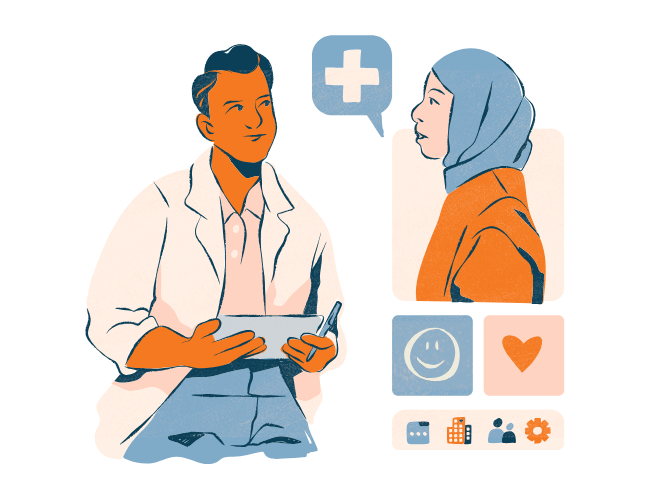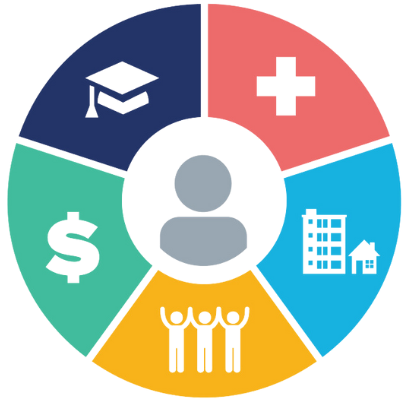
Black History Month offers a stark reminder of the persistent health disparities Black Americans face. Employers have a responsibility to go beyond celebration and take meaningful action to address these inequities. Understanding the Social Determinants of Health (SDOH) – factors like economic stability, education, and healthcare access – is crucial in creating workplaces that truly support the well-being of Black employees and promote health equity for all.
Pressed for time? Here’s a quick summary…
- Economic stability: Employers should work to promote job stability, fair pay, and professional development opportunities to foster economic stability for all employees.
- Education access and quality: Employers can support education through scholarships for employees’ family members or partnerships with educational institutions, opening doors for stable, better-paying employment and health literacy.
- Healthcare access and quality: Barriers to healthcare have led to higher rates of diseases among Black Americans. Leverage demographic data to tailor DEIB+ friendly wellness programs, initiatives, and benefits.
- Neighborhood and built environment: To compensate for limited access to recreational facilities, which often encourage physical activity, employers can provide wellness rooms and lifestyle spending accounts to support healthy, active behaviors.
- Social and community context: Implementing diversity, equity, and inclusion (DEI) training, organizing community-building activities, and practicing empathetic leadership cultivates a supportive and inclusive workplace culture.
Recognizing & Addressing Health Disparities
Health disparities for Black Americans persist despite perceived progress. These inequities stem from systemic racism and its socioeconomic consequences, including:
- Higher uninsured rates: Limiting access to preventative care and treatment.
- Disproportionate poverty rates: Reducing resources for healthy living and increasing stress.
- Environmental in
sjustice: “Sacrifice zones” expose Black communities to disproportionate health hazards. - Food insecurity: Healthy food options are scarce, impacting nutrition and chronic disease risk.
Discrimination within healthcare settings further widens these gaps, with over half of Black adults reporting negative experiences with healthcare providers.
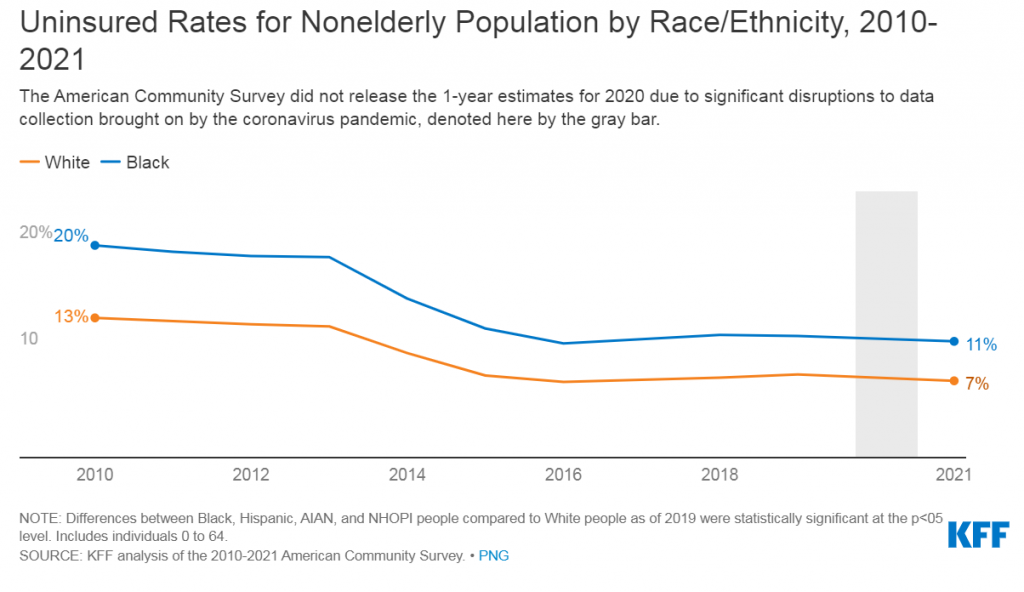
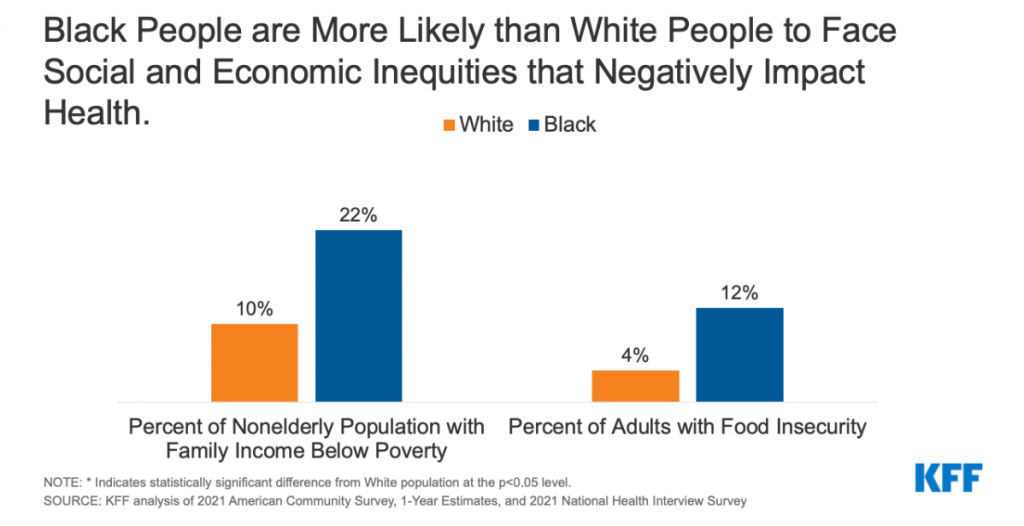
The data reveals the urgent need for systemic change to address the interconnected economic and health disparities harming Black Americans. Employers have a unique responsibility to drive equity-focused strategies, leveraging the Social Determinants of Health (SDOH) framework to create lasting change.
Social Determinants Of Health At A Glance
Understanding SDOH is essential for creating workplaces that address systemic health inequities. Here’s a breakdown of key areas and their specific impact on Black communities:
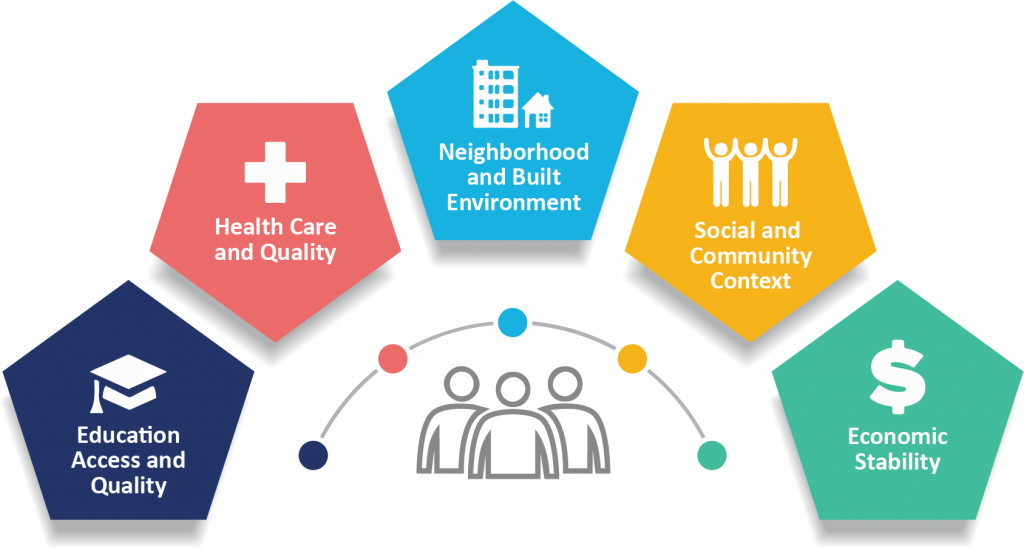
- Economic stability, which covers employment, income, expenses, debt, and medical bills. Limited job opportunities and unfair pay historically impact Black Americans’ ability to afford housing, healthcare, and other necessities.
- Education access and quality, which encompasses literacy, language, vocational training, and higher education. Segregated and underfunded schools in Black neighborhoods directly impact educational opportunities and health literacy.
- Healthcare access and quality, which includes access to healthcare, primary care, and health insurance. Bias within the healthcare system creates mistrust and limited access to care. Environmental racism further burdens Black communities with hazardous “sacrifice zones”.
- Neighborhood and built environment, which involves safe housing, access to nutritious food, air and water quality, and the presence of recreational spaces. Redlining and segregation often trap Black Americans in areas lacking safe housing, healthy food options, and clean air and water.
- Social and community context, which includes social integration, support systems, community engagement, and discrimination. Racism undercuts social support systems and worsens mental health outcomes. Discrimination hinders community engagement opportunities.
Employer Actions: Driving Health Equity For Black Employees
Black Americans face unique challenges within the SDOH framework, from accessing essential resources to achieving healthy living standards. Employers, who provide health insurance for nearly half of Americans, are uniquely positioned to drive positive change.
By recognizing the specific barriers many Black Americans face, employers can implement interventions aimed at promoting health equity. This proactive approach not only advances workplace wellness but also contributes to a broader societal shift toward health equality.
Economic Stability
Economic stability directly influences access to nutritious food, quality housing, and healthcare. Stable employment, which offers job security and fair compensation is particularly significant for Black employees in achieving health equity.

Challenges in this area may include:
- Unemployment and underemployment: Both lead to financial strain and can worsen mental and physical health, limiting healthcare access.
- Unsafe workplace conditions: Exposure to hazards and a lack of psychological safety take a toll on employees’ well-being.
- Systemic barriers to advancement: Limited opportunities for promotion and pay disparities hinder economic stability and long-term health.
Action Items For Employers
Employers must move beyond basic benefits to tackle economic inequities:
– Adopt equitable employment practices: Critically examine hiring, promotion, and pay practices for unconscious bias. Use data to track equity metrics and hold managers accountable.
– Commit to providing living wage: Ensure minimum wage offers true economic stability, especially in high-cost locations. Review pay bands regularly to maintain fairness.
– Offer professional development opportunities: Support career development and mentorship programs explicitly focused on Black employees. This combats systemic obstacles to advancement.
– Go beyond traditional benefits: Subsidized childcare, transportation assistance, and financial literacy programs directly address economic concerns impacting health.
Education Access & Quality
Access to quality education shapes employment opportunities, informs health literacy, and affects lifestyle choices. For Black Americans, equitable access to education can significantly impact health equity by providing the tools needed for better-paying, safer jobs, and informed health decisions.

Challenges in this area may include:
- Disparities in School Funding: Underfunded schools in predominantly Black neighborhoods often lack resources for STEM programs, college prep, and comprehensive health education.
- Health Literacy Gaps: Limited health education affects healthy decision-making and an individual’s ability to navigate the healthcare system effectively.
- Barriers to Advancement: Without equal access to higher education or trade certifications, career options are limited, impacting economic potential and overall health.
Action Items For Employers
Employers can support educational equity by:
– Targeted scholarships: Partner with organizations specializing in scholarships for Black students or create company-specific awards focusing on healthcare, tech, or other fields where Black employees are underrepresented.
– Continuing education programs: Offer skills-based training programs that lead to certifications, promotions, or pay increases. Prioritize skills relevant to both the workplace and employee well-being.
– Partnering with educational institutions: Collaborate with colleges, universities, and trade schools to offer tailored education programs, internships, and mentorship opportunities.
Healthcare Access & Quality
The right to quality healthcare is essential but too often remains out of reach for many Black Americans. Systemic inequities limit access to care, influence the quality of treatment, and erode trust in the healthcare system.

Challenges in this area may include:
- Limited access: Lack of insurance, affordable clinics nearby, or cultural competence within healthcare can prevent Black individuals from getting preventive care and addressing health issues early.
- Quality of care: Bias and unequal treatment have devastating consequences. Ruth Nyaamine’s experience, as highlighted below, shows how these disparities lead to real physical harm and psychological trauma.
- Systemic Neglect: Black Americans disproportionately suffer from serious yet preventable conditions:
- Diabetes: Adults are 60% more likely to be diagnosed than non-Hispanic white adults.
- Hypertension: Affects 54% of Black men and 56% of Black women, significantly higher than white populations.
- HIV/AIDS and STDs: Systemic issues like access to testing and education fuel disproportionate infection rates.
- Mental Health: Stigma and inadequate culturally competent care create devastating barriers to getting support.
Ruth Nyaamine, Chief Diversity and Inclusion Officer at Telus, shares her harrowing medical experience during pregnancy. Dismissed by healthcare professionals despite severe pain, she endured an emergency C-section and the trauma of her newborn suffering a preventable medication error. Her personal belongings were even removed from her hospital room – a dehumanizing act on top of medical neglect. Ruth’s story isn’t isolated. It embodies the systemic failures many Black women face within a healthcare system too often lacking compassion and cultural competence.
Action Items For Employers
Employers can contribute to greater healthcare access and quality by:
– Making data-driven decisions: Analyze employee health data (anonymized) to identify disparities in coverage, usage, and outcomes. This exposes where support is needed most.
– Offering benefits beyond the basics: Ensure plans cover diverse healthcare needs. Prioritize mental health coverage, preventative screenings, and access to culturally competent providers.
– Providing telehealth services: Integrating telehealth into health plans can make healthcare more accessible, especially for those facing barriers to traditional care settings.
– Offering diverse wellness providers: Include diverse providers in wellness programs. Individuals from marginalized groups are more likely to feel comfortable seeking care from a wellness professional of the same identity. Additionally, professionals from underrepresented groups can better understand the needs of those from underserved populations and deliver compassionate and judgment-free care.
Neighborhood & Built Environment
Environmental injustice places many Black Americans in unsafe neighborhoods, undermining well-being and perpetuating health disparities.

Challenges in this area may include:
- Environmental hazards: Exposure to pollutants and poor water quality increases the risk of chronic diseases like asthma, cancer, and heart disease.
- Lack of recreational areas: Limited access to parks and recreational areas reduces opportunities for physical activity.
- Unsafe housing: Substandard housing conditions causes both physical harm and ongoing stress.
Action Items For Employers
To support Black employees in this domain, employers can:
– Choose office locations wisely: When choosing office locations/expansions, consider neighborhood health indices. Ensure proximity to safe walking areas, healthy food options, and public transit benefits all employees.
– Add wellness rooms in the workplace: These spaces can encourage physical activity, relaxation, hobbies, and other practices that contribute to well-being.
– Provide lifestyle spending accounts (LSAs): LSAs provide funds for wellness-related activities. Integrating them within wellness programs can motivate employees to adopt healthier, more active lifestyles.
– Provide flexible work options: Remote or hybrid work can enable employees to live in healthier areas, even if further from the office.
Social & Community Context
Factors such as social support, discrimination, and community engagement influence stress levels, mental health, and lifestyle choices.

Challenges in this area include:
- Discrimination: Chronic stress from racism – at work and beyond – has documented negative health consequences, ranging from mental health disorders to increased risk of chronic disease.
- Limited social support: Lack of supportive social networks can exacerbate feelings of isolation and stress and makes it harder to navigate challenges.
- Community disinvestment: Neighborhoods lacking resources and safe spaces create stress and limit healthy choices. This contributes to mental health disparities and barriers to care.
Action Items For Employers
Employers can foster a workplace culture that supports diversity, inclusion, and community-building by:
– Implementing DEI training: Regular DEI sessions for all employees, coupled with targeted training for managers, can help eliminate unconscious biases.
– Reevaluating hiring and promotion: Adjust hiring practices and promotion criteria as needed to eliminate biases and ensure an equitable process for all candidates.
– Organizing community-building activities: Team-building activities, volunteer opportunities, and employee resource groups (ERGs) can build a sense of community within the workplace.
– Empathetic leadership: Training leaders in emotional intelligence allows them to effectively respond to mental health, work-life balance, or overall well-being issues.
Next Steps For Employers

As employers, initiating steps toward health equity, even if gradually, marks a significant progression. While implementing all suggestions immediately may not be feasible, starting with targeted actions can create impactful change. Consider setting a timeline to meet achievable goals, such as introducing equitable employment practices, enhancing DEI training, and expanding healthcare access. Beginning with any of these areas demonstrates a commitment to progress and justice, contributing to a healthier, more equitable workplace. Each step forward, no matter the size, is a stride towards closing the health disparity gap.



